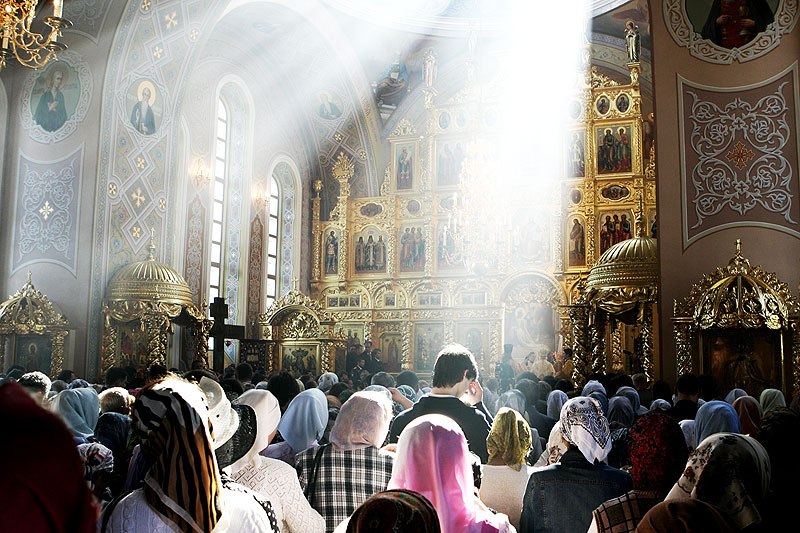|
The Orthodox Church: An Introduction An ever-growing number of individuals from various backgrounds are becoming interested in the Orthodox Church. These individuals are discovering the ancient faith and rich traditions of the Orthodox Church. They have been attracted by her mystical vision of God and His Kingdom, by the beauty of her worship, by the purity of her Christian faith, and by her continuity with the past. These are only some of the treasures of the Church, which has a history reaching back to the time of the Apostles. Eastern Christianity The Orthodox Church embodies and expresses the rich spiritual treasures of Eastern Christianity. It should not be forgotten that the Gospel of Christ was first preached, and the first Christian communities were established, in the lands surrounding the Mediterranean Sea. It was in these eastern regions of the Roman Empire that the Christian faith matured during its struggle against paganism and heresy. There, the great Fathers lived and taught. There, in the cities of the East, the fundamentals of our faith were proclaimed at the Seven Ecumenical Councils. The spirit of Christianity nurtured in the East had a particular “flavor.” Its “shape” was distinct, though its faith was identical, to that which developed in the Western portion of the Roman Empire and its subsequent Medieval Kingdoms. While Christianity in the West developed in lands which knew the legal and moral philosophy of Ancient Rome, Eastern Christianity developed in lands which knew the cultures of Judaism and Hellenism. While the West was theologically more focused on the Passion of Christ and the sin of man, the East emphasized the Resurrection of Christ and the deification of man. While the West leaned toward a legalistic view of religion, the East embraced a more mystical theology. Since the Early Church was not monolithic, the two great traditions existed together for more than a thousand years until the Great Schism of the eleventh century. Today, Roman Catholics and Protestants are heirs to the Western tradition, and the Orthodox are heirs to the Eastern tradition. Orthodox Christians of the Eastern Churches call themselves Orthodox. This description comes to us from the fifth century and has two meanings which are closely related. The first definition is “normative (or true) teaching.” The Orthodox Church believes that She has maintained and handed down the Christian faith, free from error and distortion, from the days of the Apostles. The second definition, is “normative (or true) praise (or worship).” The fundamental purpose of the Church is to bless, praise, and glorify God the Father, Son, and Holy Spirit. All Her activities, and all Her dogmatic and doctrinal formulations, are directed toward this purpose. Christians, of the Eastern Churches also regard themselves as Catholic. This description, dating back to the second century, is embodied in the Nicene Creed, which acknowledges “One, Holy, Catholic, and Apostolic Church.” From the Orthodox perspective, “catholic” means that the Church is universal, that it includes persons of all races and cultures: it is the Church in all places at all times for all peoples. “Catholic” also affirms that the Church has preserved the fullness and universality of the Christian faith. Sometimes adjectives such as “Greek,” “Russian,” “Antiochian,” “Serbian,” “Romanian,” etc. are used in identifying the Orthodox Churches in the countries corresponding to these nationalities. They may also be used in North America simply to indicate the cultural and national roots of the immigrants that initially founded a particular parish or diocese. But – preeminently – all are Orthodox and all are united in one singe faith and communion. Orthodoxy in the West Orthodox Christianity has evolved over the past two and a half centuries in North America. It is believed that the first Orthodox Christians arrived in the New World from Greece in 1768, and established a colony near the present city of Saint Augustine, Florida. The community was temporary, but one of the buildings in which these immigrants worshipped was acquired and renovated to house the Saint Photius Shrine of the Greek Orthodox Archdiocese. The chapel is a national religious landmark, bearing witness to the presence of Orthodoxy in America. The first missionary and permanent presence of Orthodox Christianity on the American Continent was established by the Moscow Patriarchate of the Russian Orthodox Church in 1794 when eight missionaries traveled 7,300 miles in 293 days from Valaamo Monastery in Karelia to Kodiak, Alaska. These missionaries led many Native Americans to the Orthodox Christian faith, preached from Alaska south into northern California. Like every other Christian tradition in America, the Orthodox Church in our nation has its origins in the faith of immigrants the Old World. Like the first Apostles, they carried with them a precious heritage and gift. To the New World they brought the ancient faith of the Orthodox Church. Again, like every other Christian tradition in America, the Orthodox Church today is comprised of individuals born here. The Orthodox Church is not a “foreign” or “exotic” presence here, but it is simply “American” like all other Christian traditions in America Diversity in Unity The Orthodox Church is a worldwide communion of Churches. In some regards it may be compared to the Anglican Communion. Each church is independent in her internal organization and follows her own particular customs. The Orthodox Church is “hierarchical” and “liturgical.” In this regard it is comparable to the Roman Catholic Church – which developed in the West after the 11th-century Great Schism. The Orthodox Church recognizes that unity does not mean uniformity. It is a fundamental principal, of course, that all the Churches are united in the exact, same, unchanging faith and order that was established by Jesus Christ and preached by His Apostles. In regard to some minor practices and musical traditions, there is a rich diversity. Some churches are rich in history, such as the Church of Constantinople. Others are relatively young, such as the Churches of Finland, Albania, and the Czech Lands. Some are large, such as the Church of Russia, while others are small, such as the Church of Sinai. Each Church is led by a synod of its bishops whose singular duty is to preserve the Orthodox faith pure and unchanged.
|


